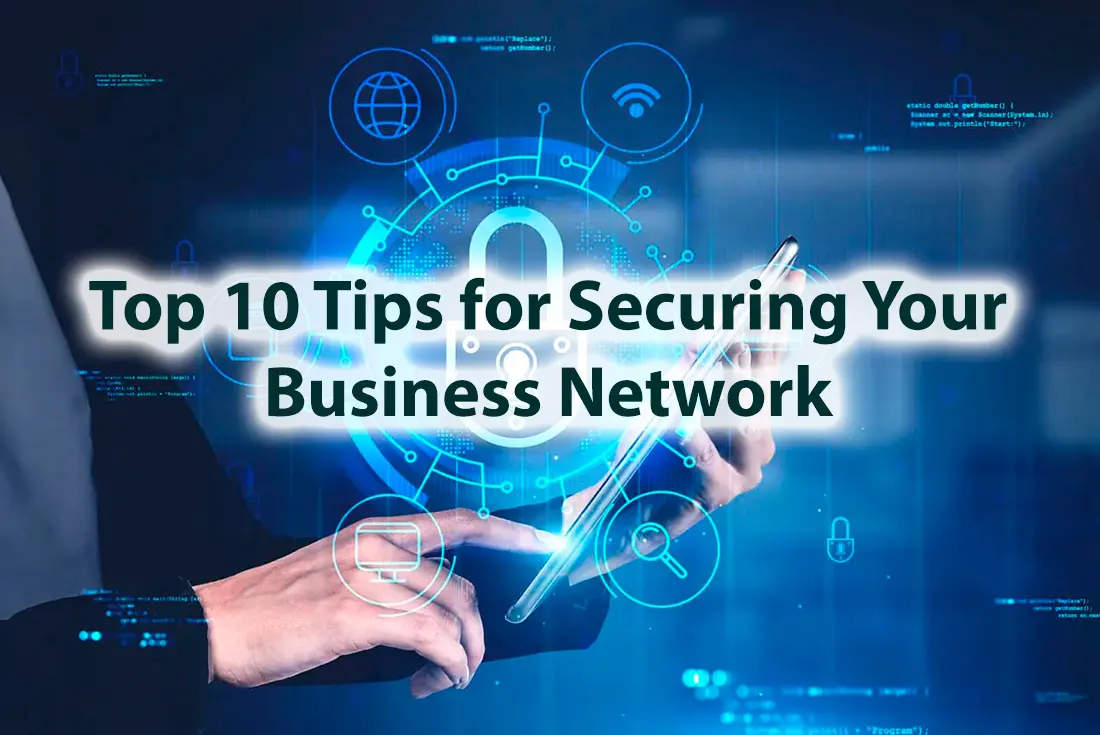
27 May Top 10 Tips for Securing Your Business Network
Cybersecurity isn’t just for big corporations. Small and medium businesses are increasingly targeted by hackers, making robust network security essential for survival. Every day, companies face data breaches, ransomware attacks, and other cyber threats that can disrupt operations, compromise sensitive information, and damage reputations. The good news is that you don’t need a massive IT budget to protect your business. We’ve prepared ten practical, actionable tips to help you fortify your network and safeguard your valuable assets.
1. Deploy a Unified Threat Management (UTM) System
A Unified Threat Management (UTM) system like Fortinet FortiGate UTM, Sophos SG UTM, and Cisco UTM is an all-in-one security solution that integrates multiple security features into a single appliance or software package. This simplifies network security management and provides comprehensive protection against various threats. Usually, UTM systems include a firewall, IPS, web filtering, spam filtering, gateway antivirus, and VPN. Here’s what they do:
- Firewall controls incoming and outgoing network traffic, blocking unauthorized access.
- Intrusion Prevention System (IPS) monitors network traffic for suspicious activity and blocks potential threats.
- Web filtering prevents access to malicious websites or inappropriate content.
- Spam filtering blocks unwanted emails and potential phishing attempts.
- Gateway antivirus and antimalware scans all incoming and outgoing traffic for malicious software.
- Virtual private network (VPN) provides secure remote access for employees working off-site.
Deploying a UTM system lets you protect your network from multiple threats without the complexity and cost of managing separate security solutions—just what a small business needs! To deploy a UTM system, you will probably need the help of an IT support service. At Downtown Computer Services, we help with organizing and setting up business networks and, of course, with cybersecurity issues. Call us at (954) 524 9002 to fortify your network and keep your business safe.
2. Train Your Employees
Even with the best security technology in place, human error can still lead to a breach. And it usually does! That’s why regular security awareness training is essential for educating your staff. Ensure they know how to identify and avoid phishing scams and practice safe internet habits for browsing, downloading files, and using email. Reinforce the importance of creating strong, unique passwords and avoiding password reuse. Educate them on social engineering tactics so they can recognize and report suspicious requests for information. Lastly, establish clear procedures for handling sensitive data to minimize the risk of accidental exposure or loss.
3. Use Strong Authentication Methods
Strong authentication goes beyond passwords. Implementing multi-factor authentication (MFA) adds an extra layer of security by requiring users to provide additional verification factors, such as a code sent to their phone or a fingerprint scan. This makes it much harder for attackers to gain access to your network, even if they have obtained a user’s password.
Consider requiring MFA for all employees, especially those with access to sensitive data or critical systems. You can also implement strong password policies requiring complex passwords, regular password changes, and the use of password managers.
4. Regularly Update and Patch Systems
Software vulnerabilities are a common target for cyberattacks. Hackers exploit these weaknesses to gain access to your network and steal data. Regularly updating and patching your operating systems, applications, and firmware is crucial for protecting against these vulnerabilities.
Set up automatic updates whenever possible and schedule regular maintenance windows to apply patches and updates promptly. This helps ensure that your systems are up to date with the latest security fixes, reducing the risk of exploitation.
5. Backup Data Regularly
Imagine losing all your customer data, financial records, or project files due to a cyberattack, hardware failure, or natural disaster. Regular backups are essential to protect your business from such catastrophic data loss. Backups create copies of your important files and store them in a separate location, either on an external hard drive, a network-attached storage (NAS) device, or in the cloud. This way, if something happens to your primary data, you have a backup copy to restore from.
Establish a regular backup schedule, such as daily or weekly, depending on how often your data changes. Use dedicated backup software that automates the process and allows you to easily restore files when needed. Don’t forget to test your backups regularly to ensure they are working properly and can be recovered successfully.
6. Secure Wi-Fi Networks
Your Wi-Fi network is a potential entry point for cybercriminals if not properly secured. Hackers can intercept traffic, steal data, or even gain access to your entire network through an unsecured Wi-Fi connection. We’ve put together a list of a few ways you can fortify your wireless defenses.
Use Strong Encryption
Use the latest encryption protocols like WPA3 for maximum security. If your devices don’t support WPA3, use WPA2 with AES encryption, which is still considered secure. Avoid using outdated protocols like WEP, as they are easily cracked.
Use Unique and Complex Passwords
Create a strong password for your Wi-Fi network that is at least 12 characters long and includes a mix of uppercase and lowercase letters, numbers, and symbols. Avoid using easily guessable information like your business name or address.
Hide Your SSID
Disable the broadcasting of your network’s SSID (name). This makes it harder for unauthorized users to discover your network.
Create a Guest Network
If you need to provide Wi-Fi access to guests, create a separate guest network with limited access to your internal resources. This isolates guest traffic and prevents them from accessing sensitive data.
Filter MAC Addresses
Consider implementing MAC address filtering, which allows only specific devices to connect to your network based on their unique hardware identifiers. However, be aware that this can be time-consuming to manage and may not be effective against determined attackers.
Regularly Update Firmware
Keep your router’s firmware fresh. Firmware updates often include security patches that fix vulnerabilities that could be exploited by hackers.
7. Segment Your Network
Network segmentation is dividing your network into smaller, isolated segments, each with its own security controls and access restrictions. This approach limits the spread of malware and protects sensitive data by isolating it.
For example, you can create separate segments for your point-of-sale systems, employee workstations, and guest Wi-Fi. By doing so, if one segment is compromised, the attacker cannot easily access other segments, preventing a wider spread of the breach.
Even basic segmentation will make your network more resilient to cyberattacks, improve performance by reducing congestion and optimizing traffic flow. Also, if your business needs to comply with regulations like HIPAA or PCI DSS, network segmentation can help you meet the requirements for data isolation and access control.
8. Implement Endpoint Protection
Endpoints, such as laptops, desktops, and mobile devices, are often the weakest link in network security. Use antivirus and antimalware solutions on all endpoints to protect against threats entering through these devices. Keep the software updated and run regular scans to detect and remove any malicious software.
9. Control Physical Access
Physical access to your network components, such as servers and routers, should be strictly controlled. Limit access to authorized personnel only and use surveillance measures like security cameras to deter and detect unauthorized access.
10. Develop a Response Plan
Despite your best efforts, security breaches can still happen. Having a clear incident response plan in place can help you manage and recover from a breach effectively. The plan should outline the steps to take in case of a security incident, including:
- Identifying and isolating the affected systems
- Containing the breach to prevent further damage
- Investigating the cause of the breach
- Notifying affected parties
- Restoring systems and data from backups
- Implementing measures to prevent similar incidents in the future
Regularly review and update your incident response plan to ensure it remains relevant and effective.
Conclusion
Protecting your small business network doesn’t have to be a complex undertaking. By implementing a unified threat management system, educating your employees, utilizing strong authentication methods, regularly updating your systems, backing up your data, securing your Wi-Fi, segmenting your network, implementing endpoint protection, controlling physical access, and developing a response plan, you can create a robust defense against cyber threats.
Cybersecurity is an ongoing process, so remain vigilant, adapt to evolving threats, and prioritize the security of your valuable data and systems. If you prefer to spend time on business rather than technical issues, then contact Downtown Computer Services for IT support: (954) 524 9002.
Key Takeaways
- Small and medium businesses are increasingly targeted by hackers, making robust network security essential for survival.
- Human error can lead to breaches, so regular security awareness training for employees is crucial.
- Implementing a combination of technical solutions (like UTM systems, strong authentication, and regular updates) and non-technical measures (like employee training, physical access control, and incident response plans) is key to effective cybersecurity.
Check out other relevant news
- How Easy-to-Use Hacking Tools Are Fueling Cybercrime
- Cryptocurrency Security for Small Businesses: Protecting Your Wallet
- The Infostealer Epidemic: Protecting Your Business from the Latest Wave of Cyberattacks
- The Identity Crisis: How Compromised Credentials Can Cripple Your Business
- Beyond the Brick and Mortar: Building Your Online Storefront with Digital Marketing
